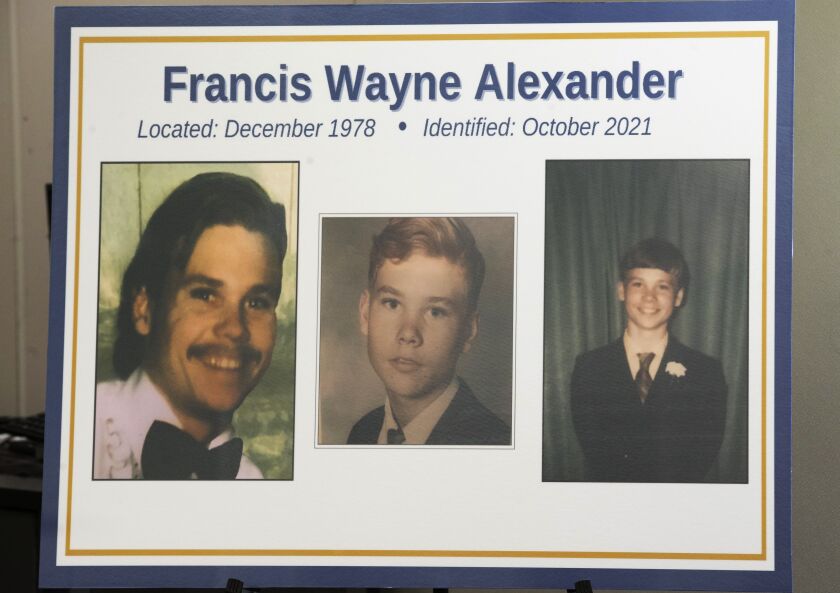Another victim of serial killer John Wayne Gacy was identified by the Cook County Sheriff’s Office on Monday.
Francis Wayne Alexander, whose remains were found in Gacy’s crawl space in December 1978, is the third victim identified after Sheriff Tom Dart in 2011 reopened an investigation into Gacy’s murders of 33 people decades ago.
Alexander is one of eight victims whose remains have been exhumed in the new investigation. DNA extracted from one of his molars was eventually used to identify him.
Cook County Sheriff’s Lt. Jason Moran, who leads the investigation, said Alexander’s family felt a strong sense of closure upon hearing the news.
“Every family member we’ve met with, every family we’ve helped, overwhelmingly said it’s better to know than not to know, even if the news is your loved one was killed by an evil, evil man,” he said Monday.
Alexander is the first victim identified in the past decade with a parent who is still alive. He is also survived by two half-sisters and two half-brothers, who, along with his mother, live in North Carolina.
“It is hard, even 45 years later, to know the fate of our beloved Wayne. He was killed at the hands of a vile and evil man,” Alexander’s relatives said in a statement. “Our hearts are heavy and our sympathies go out to the other victims’ families. Our only comfort is knowing this killer no longer breathes the same air as we do.”
The life of Francis Wayne Alexander
Sheriff Dart said the family originally thought Alexander had willingly cut off communication with them, so they never filed a missing persons report.
“There was family that loved him, but he had made decisions in his life that led them to believe that he just wanted to be left alone,” Dart said.
Alexander, who was around 21 at the time of his murder, lived on the North Side of Chicago. He moved to the city in 1975 after being married in New York, and worked in various bars and clubs, Moran said.
The only thing connecting Alexander to the other victims was that he lived in an area on the North Side that Gacy targeted. He lived on Winona Street, only blocks away from victim Bill Bundy.
Gacy hid the bodies of his victims throughout his Cook County home just east of O’Hare Airport on the Northwest Side. Alexander was one of many victims found in the crawl space of the home, where Gacy covered the bodies with acid and lime.
New help from DNA technology
Alexander’s family members thanked the DNA Doe Project, a California nonprofit that worked with the sheriff’s office to use genetic information to help locate the relatives of unknown victims.
In years past, law enforcement could only examine DNA samples submitted by the public, but through the nonprofit’s use of online DNA database GEDmatch, the pool of samples has dramatically expanded.
In addition, the online database can look at DNA from more distant relatives. In this case, DNA of a second cousin and fifth cousin were found to be a close match of Alexander. In the past, traditional DNA matching only enabled law enforcement to find victims from samples of close relatives, like a parent or child, said Cairenn Binder, an investigative genealogist for the DNA Doe Project.
After identifying Alexander, the nonprofit shared the finding with the sheriff’s office, which then examined public records for traces of him.
The office found that Alexander received a parking ticket in January 1976 and earned little income in 1976. With no proof of life after that time, investigators found Gacy likely murdered Alexander between early 1976 and early 1977.
While the sheriff’s office works to solve other missing persons cases, officials will continue their investigation of the late serial killer. Five unknown victims remain, although the quality of the DNA from those remains is not as good, Moran said.
As genetic technology advances, Dart says his office will be able to solve more cases.
“I can’t emphasize enough to you, talking to these different families over these years, it’s often heartbreaking,” he said. “But there’s this sense of relief that you feel from talking to them, that they’ve been waiting their whole life to get this call, to have this resolved. And it means everything to them.”
The sheriff’s office and officials at the DNA Doe Project encouraged the public to submit their own DNA to the sheriff’s office as well as to online databases like GEDmatch. Beyond Gacy, the samples are an invaluable resource so officials can ultimately bring closure to families of the thousands of victims of other unsolved murders, officials said.
“We should continue until we can identify each and every missing person that we have,” Dart said.









